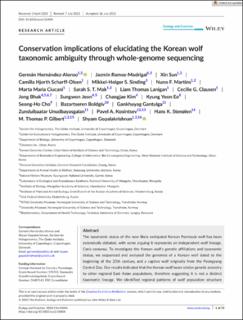| dc.contributor.author | Hernández-Alonso, Germán | |
| dc.contributor.author | Ramos-Madrigal, Jazmín | |
| dc.contributor.author | Sun, Xin | |
| dc.contributor.author | Scharff-Olsen, Camilla Hjorth | |
| dc.contributor.author | Sinding, Mikkel Holger Strander | |
| dc.contributor.author | Martins, Nuno F. | |
| dc.contributor.author | Ciucani, Marta Maria | |
| dc.contributor.author | Mak, Sarah S. T. | |
| dc.contributor.author | Lanigan, Liam Thomas | |
| dc.contributor.author | Clausen, Cecilie G. | |
| dc.contributor.author | Bhak, Jong | |
| dc.contributor.author | Jeon, Sungwon | |
| dc.contributor.author | Kim, Changjae | |
| dc.contributor.author | Eo, Kyung Yeon | |
| dc.contributor.author | Cho, Seong-Ho | |
| dc.contributor.author | Boldgiv, Bazartseren | |
| dc.contributor.author | Gantulga, Gankhuyag | |
| dc.contributor.author | Unudbayasgalan, Zunduibaatar | |
| dc.contributor.author | Kosintsev, Pavel A. | |
| dc.contributor.author | Stenøien, Hans Kristen | |
| dc.contributor.author | Gilbert, Marcus Thomas Pius | |
| dc.contributor.author | Gopalakrishnan, Shyam | |
| dc.date.accessioned | 2023-11-16T08:03:55Z | |
| dc.date.available | 2023-11-16T08:03:55Z | |
| dc.date.created | 2023-08-22T13:21:27Z | |
| dc.date.issued | 2023 | |
| dc.identifier.issn | 2045-7758 | |
| dc.identifier.uri | https://hdl.handle.net/11250/3102885 | |
| dc.description.abstract | The taxonomic status of the now likely extirpated Korean Peninsula wolf has been extensively debated, with some arguing it represents an independent wolf lineage, Canis coreanus. To investigate the Korean wolf's genetic affiliations and taxonomic status, we sequenced and analysed the genomes of a Korean wolf dated to the beginning of the 20th century, and a captive wolf originally from the Pyongyang Central Zoo. Our results indicated that the Korean wolf bears similar genetic ancestry to other regional East Asian populations, therefore suggesting it is not a distinct taxonomic lineage. We identified regional patterns of wolf population structure and admixture in East Asia with potential conservation consequences in the Korean Peninsula and on a regional scale. We find that the Korean wolf has similar genomic diversity and inbreeding to other East Asian wolves. Finally, we show that, in contrast to the historical sample, the captive wolf is genetically more similar to wolves from the Tibetan Plateau; hence, Korean wolf conservation programmes might not benefit from the inclusion of this specimen. | en_US |
| dc.language.iso | eng | en_US |
| dc.publisher | John Wiley & Sons Ltd | en_US |
| dc.rights | Navngivelse 4.0 Internasjonal | * |
| dc.rights.uri | http://creativecommons.org/licenses/by/4.0/deed.no | * |
| dc.title | Conservation implications of elucidating the Korean wolf taxonomic ambiguity through whole-genome sequencing | en_US |
| dc.title.alternative | Conservation implications of elucidating the Korean wolf taxonomic ambiguity through whole-genome sequencing | en_US |
| dc.type | Peer reviewed | en_US |
| dc.type | Journal article | en_US |
| dc.description.version | publishedVersion | en_US |
| dc.source.volume | 13 | en_US |
| dc.source.journal | Ecology and Evolution | en_US |
| dc.source.issue | 8 | en_US |
| dc.identifier.doi | 10.1002/ece3.10404 | |
| dc.identifier.cristin | 2168749 | |
| cristin.ispublished | true | |
| cristin.fulltext | original | |
| cristin.qualitycode | 1 | |

